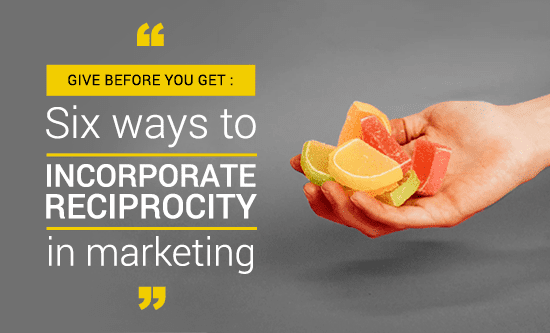When discussing the concept of reciprocity, there are two main trains of thought within the marketing community. The first group sees reciprocity as a flawed concept that simply ‘gives away’ free products with no guarantee of anything in return. On the flip side, the vast majority of marketers see the principle as an absolutely integral lever that can be utilised to create a sense of connectivity and potential indebtedness between the customer and their business.
As Dr. Robert Cialdini outlined in his book “Influence: The Psychology of Persuasion”, reciprocity represents a fundamental human desire to want to provide something back after something has already been received. Reciprocity also remains one of the fundamental principles of marketing psychology. In his book, Cialdini shares a case study titled ‘the Surprise Mint’ that clearly demonstrates the value of the reciprocity effect. In the study, it was discovered that on average, a restaurant waiter’s tip increased by approximately 3% when diners were given a mint along with their bill. This figure increased substantially to 14% when provided with two mints.
In order to fully benefit from reciprocity in marketing, there are six golden rules to abide by. These are:
- Give something first:
this can be in any form such as gifts, points, discounts or exclusive offers. To make the most out of this principle, an additional incentive can be offered post-sale, laying the foundations for future business or referrals. - Utilise knowledge and information:
provide your customers with something of value. By offering them information such as guides, e-books or instruction videos, it is significantly more likely that they’ll be interested in reciprocating. - Offer free-trials:
music giant Spotify has used this tactic with great success. By providing a free 30-day trial for Premium Membership, customers become reluctant to cancel at the end of the trial period. Other companies like DropBox use similar approaches. - Be personal:
there is nothing that irks customers more than being treated like a number. To address this, send them a personalised message after their purchase to make them feel valued and engaged. This will also assist with long-term relationship building and customer engagement. - Make them feel unique:
everyone likes to feel special from time to time. Whether it’s a complimentary glass of champagne at a restaurant, or a room upgrade at a hotel, it’s almost guaranteed your customer will respond favourably. - Provide a parting ‘gift’:
following the initial acts of reciprocity between customer and business, it’s also a good idea to offer a final gesture of continued support. This can be in the form of mailing list subscriptions, coupons or general updates.
It’s important to keep in mind that the reciprocity rule must be used carefully and cannot be considered an ‘instant fix’ for your marketing. For example, reciprocity between you and a customer will not occur immediately. Instead, reciprocity needs to be utilised as a tool that is part of the broader customer experience. If a customer feels pressured to give back too soon, a feeling of resentment may ensue and no sale will occur.
If implemented correctly, the reciprocity principle has the power to change your business. By aligning your communications and interactions with the overarching human desire to reciprocate, you’ll soon discover that there is significant room to boost the current return on your investment. Furthermore, with more robust connections between yourself and your customers, you will see greater conversions and a solid customer base to expand upon.
 By Kitty Shui, Data-driven Strategy Specialist at Digital Alchemy.
By Kitty Shui, Data-driven Strategy Specialist at Digital Alchemy.
[pardot-form id=”46577″ title=”Blog Sign up test1″]



